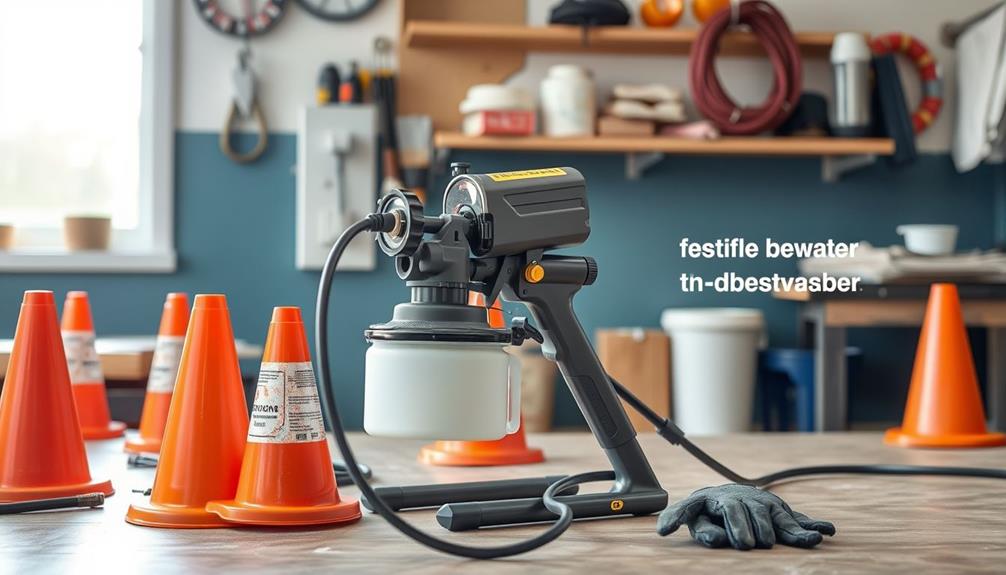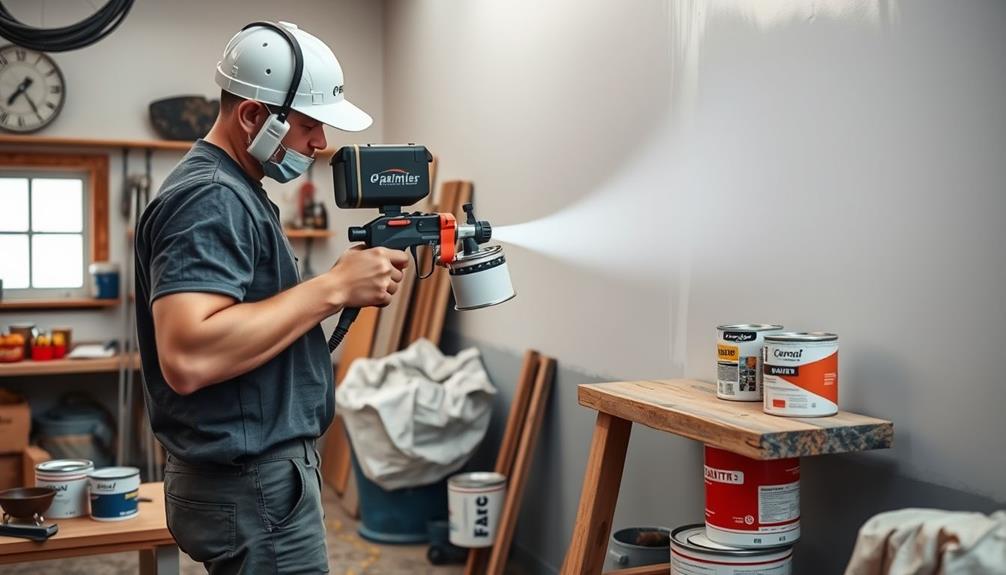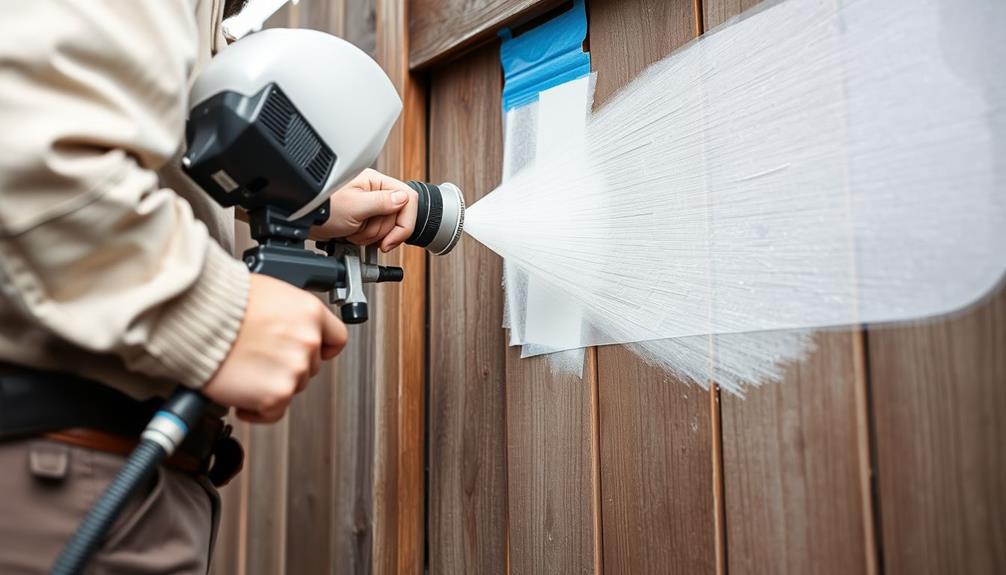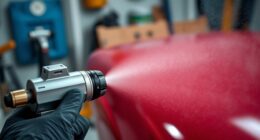To keep your airless paint sprayer safe, be aware of electrical hazards. Always ground your equipment to prevent static charge buildup, which can cause sparks. Follow NFPA 33 guidelines to guarantee proper grounding and check connections regularly for wear or damage. Organize your workspace to avoid tripping over cords and potentially disconnecting equipment unintentionally. Use safety goggles and maintain equipment to minimize risks. Remember, proper ventilation is vital to prevent flammable vapor accumulation. By taking these precautions, you'll enhance safety during operation and protect against electrical hazards. Discover more tips to stay safe while spraying!
Key Takeaways
- Ensure proper grounding of the spray system to prevent static charge buildup and reduce fire risks.
- Regularly inspect electrical connections and hoses for wear or damage to avoid shorts and electrical faults.
- Maintain a well-organized spray area to minimize tripping hazards and accidental disconnections of equipment.
- Use appropriate safety equipment, including safety goggles and respirators, to protect against splashes and harmful fumes.
- Follow NFPA 33 guidelines for grounding techniques and safety standards compliance during spraying operations.
Understanding Electrical Hazards
When using an airless paint sprayer, it's important to understand the electrical hazards involved. One major concern is static charge buildup, which can occur if your spray system isn't properly grounded. This increases the risk of sparks, potentially igniting flammable vapors in your workspace.
To mitigate these risks, follow NFPA 33 guidelines and verify your equipment is well-grounded. Additionally, maintaining a safe environment is essential, as air purifiers improve indoor air quality considerably by reducing harmful particles that could compromise safety.
Regular inspections of electrical connections and hoses are important. Look for signs of wear or damage that could lead to electrical shorts, which might cause equipment failure or even fire hazards.
All electrical components, including power cords and plugs, must meet safety standards and be rated for the voltage and current specific to your airless paint sprayer.
Additionally, maintaining a clean and organized spray area is crucial. It helps reduce the risk of tripping over electrical cords, which can lead to accidental disconnections and introduce further electrical hazards.
Preventing Fluid Injection
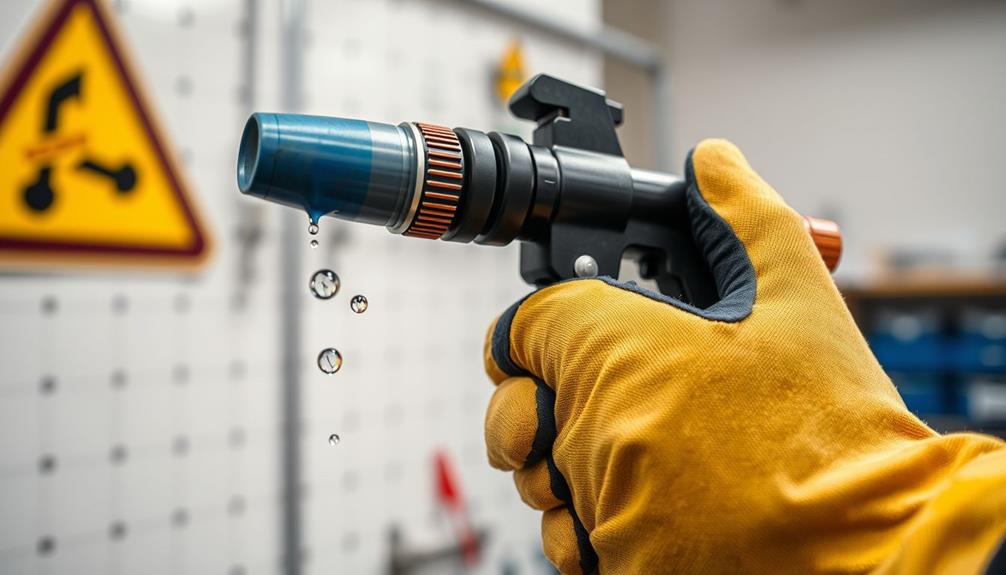
Electrical safety is just one aspect of using an airless paint sprayer, but preventing fluid injection injuries is equally essential. High-pressure fluid can penetrate your skin, causing severe injuries, especially near spray tips or leaking hoses.
To guarantee safe operation, always familiarize yourself with the best practices for maintenance and proper handling techniques.
Here's how you can protect yourself:
- Use Tip Guards: Always attach tip guards when spraying to minimize the risk of fluid injection.
- Engage Trigger Safety: When not using the spray gun, engage the trigger safety to prevent accidental activation.
- Check Trigger Features: Regularly inspect the trigger safety features to guarantee they're functioning correctly.
- Relieve Fluid Pressure: Before performing maintenance or cleaning, always relieve fluid pressure to avoid unexpected injections.
Fire and Explosion Risks
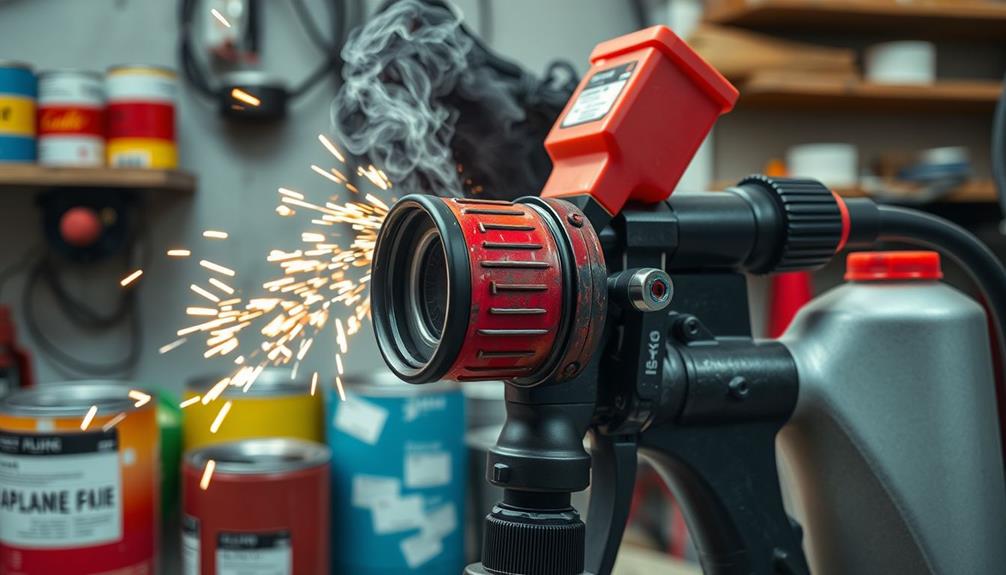
While using an airless paint sprayer, it's important to recognize the fire and explosion risks associated with flammable materials.
Home security systems can help protect your workspace by deterring potential intrusions and guaranteeing immediate response in case of emergencies.
Spraying in poorly ventilated areas can lead to the accumulation of ignitable vapors, greatly increasing the chance of fire and explosion. Always make sure you're working in a well-ventilated space to keep those vapors dispersed.
Open flames or sparks nearby can ignite flammable vapors almost instantly, so it's imperative to control all ignition sources during your spraying operations.
Additionally, static electricity from ungrounded spray systems can create sparks that pose a serious risk when you're handling flammable materials.
High concentrations of ignitable particles in the air can also lead to ignition and explosion, making adequate ventilation and air circulation crucial.
Regularly inspect and maintain your electrical equipment and spray systems to prevent electrical faults that could trigger fire hazards.
By taking these precautions, you can greatly reduce the risk of fire and explosion while using your airless paint sprayer.
Always stay vigilant and prioritize safety to maintain a secure working environment.
Safety Equipment and Maintenance
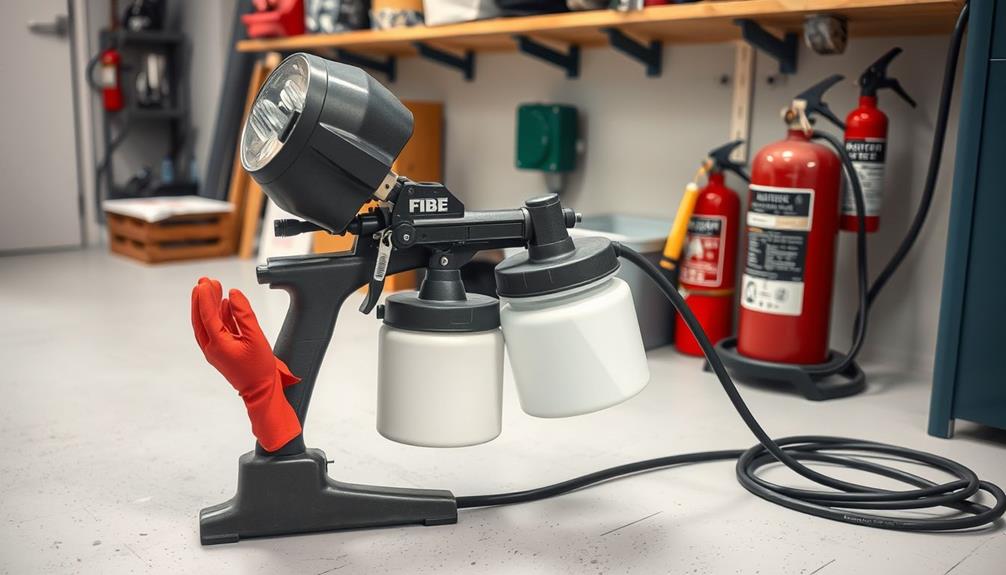
Safety equipment and maintenance are essential for guaranteeing a secure working environment with airless paint sprayers. You need to prioritize your safety by using the right gear and keeping your equipment in top shape. Here are some vital steps to follow:
- Wear Safety Goggles: Protect your eyes from fluid splashes and potential electrical hazards while operating the sprayer. Regular inspections can help identify risks before they escalate, similar to how blockage detection is important for toilet maintenance to prevent clogs.
- Inspect Hoses and Connections: Regularly check for leaks and damage, as compromised components can lead to electrical hazards and equipment failure.
- Guarantee Proper Grounding: Make sure all spray equipment is properly grounded to prevent static electricity buildup, which can lead to sparks and fires.
- Keep Metal Guards in Place: Always have metal guards on spray guns to prevent accidental trigger activation, reducing the risk of unexpected fluid discharge and electrical incidents.
Additionally, maintain an updated operator's manual for your airless paint sprayer. This manual includes vital safety guidelines and maintenance recommendations to guarantee safe operation.
Respiratory Risks

When you're using an airless paint sprayer, proper ventilation is crucial to protect your lungs from harmful fumes.
Essential oils, like eucalyptus, can also support respiratory health, making them a beneficial addition to your workspace for promoting clean air aromatherapy benefits.
You should always wear the right respirator based on the coating you're applying to guarantee your safety.
Regularly checking air quality in your spray area can help you stay ahead of potential respiratory risks.
Proper Ventilation Importance
Proper ventilation in spray booths is vital for protecting your health while working with airless paint sprayers. Without proper ventilation, harmful fumes from coatings can accumulate, leading to serious respiratory risks. Adhering to safety guidelines is important to maintain a safe working environment.
Additionally, guaranteeing that your workspace is well-ventilated aids in optimizing metabolism, similar to the altitude acclimatization benefits observed during high-altitude activities.
Here are key points to reflect on regarding proper ventilation:
- Air Changes: OSHA recommends a minimum of 4 to 12 air changes per hour in spray booths to guarantee effective dispersal of harmful vapors.
- Fire Safety: Inadequate ventilation increases the risk of flammable vapors building up, which can lead to fire or explosion hazards in the spray area.
- Toxic Inhalation: Operating airless spray systems in well-ventilated areas helps prevent the inhalation of toxic substances that may cause acute or chronic health issues.
- Regular Monitoring: Consistent air quality checks in spray areas help guarantee compliance with safety standards and protect you from respiratory hazards.
Respirator Usage Guidelines
Wearing the right respirator is vital for protecting yourself from harmful fumes and particles while using airless paint sprayers. To guarantee your safety, follow these respirator usage guidelines closely.
First, choose respirators that are rated specifically for the coatings you're spraying. This assures protection against the unique chemicals and particles involved. Additionally, it's important to confirm that your workspace is free from potential hazards, much like how maintaining a dog's health involves regular vet check-ups to monitor potential issues regular vet check-ups.
Next, make sure the spraying area meets OSHA air change requirements. This helps maintain air quality and reduces inhalation risks. Regularly monitor the air quality during your spray operations. This proactive approach enables you to identify and mitigate respiratory hazards effectively.
Additionally, use respirators equipped with filters compatible with the chemicals in your spray materials. This guarantees maximum protection against harmful exposure.
Selecting the Right Spray Tips
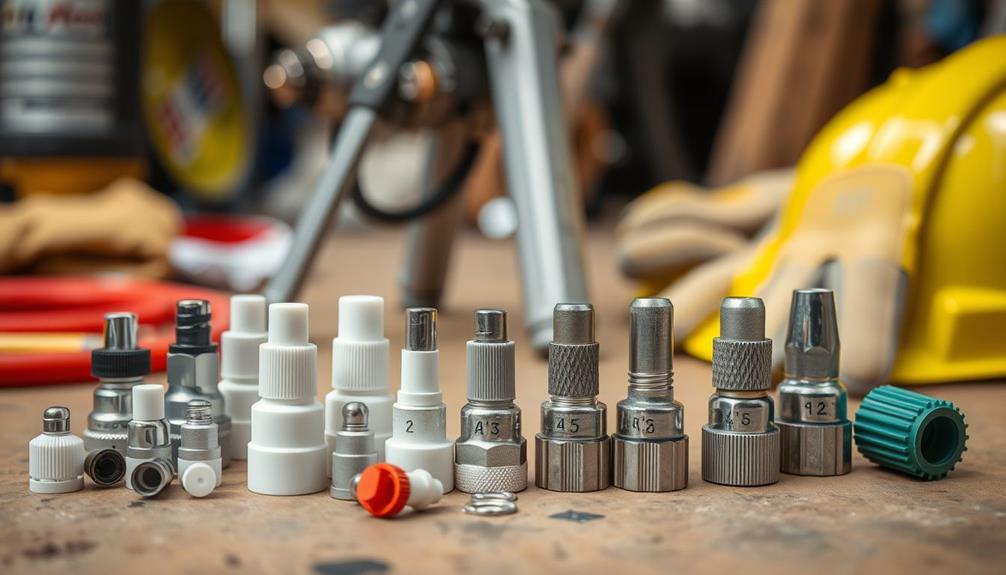
Selecting the right spray tip is essential for achieving a smooth and even finish on your projects. The fan-width and orifice-size of spray tips directly influence coating thickness and application efficiency. Choosing the correct tip not only enhances performance but also prevents issues like overspray or uneven coverage.
For instance, using the right tip can enhance your results when utilizing revolutionary spray technology like the Graco FFLP Fine Finish Low Pressure Reversible Tip for intricate projects.
Here are some key points to take into account when selecting spray tips:
- Application Type: Determine whether you need a fine finish or a heavy coating. Different tasks require specific tip configurations.
- Tip Size: Match the orifice size to your paint's viscosity. Thicker paints typically need larger tips for maximum flow.
- Condition of Tips: Regularly inspect your spray tips. Worn or damaged tips can compromise the spray pattern, leading to streaks or drips.
- Familiarity with Characteristics: Understand the different types of spray tips available. Knowing their characteristics will help you make informed choices for each project.
Proper Spraying Techniques

Achieving a flawless finish goes beyond just picking the right spray tip; it also hinges on how you operate the airless paint sprayer. To guarantee safety while paint spraying, follow these proper techniques.
| Technique | Description | Safety Tip |
|---|---|---|
| Workspace Organization | Keep your area clean to prevent tripping hazards. | Maintain a clutter-free zone. |
| Equipment Inspection | Regularly check hoses and connections for damage. | Prevent leaks and failures. |
| Ventilation | Verify the spraying area is well-ventilated. | Reduce flammable vapor buildup. |
When using your spray gun, make certain to employ non-sparking tools to minimize the risk of igniting flammable vapors. Always be cautious of electrical sources while operating. It's crucial to operate the airless sprayer in a well-ventilated area to further reduce risks. Remember, static electricity can build up if the sprayer isn't grounded, leading to potential electrical hazards.
Importance of Grounding
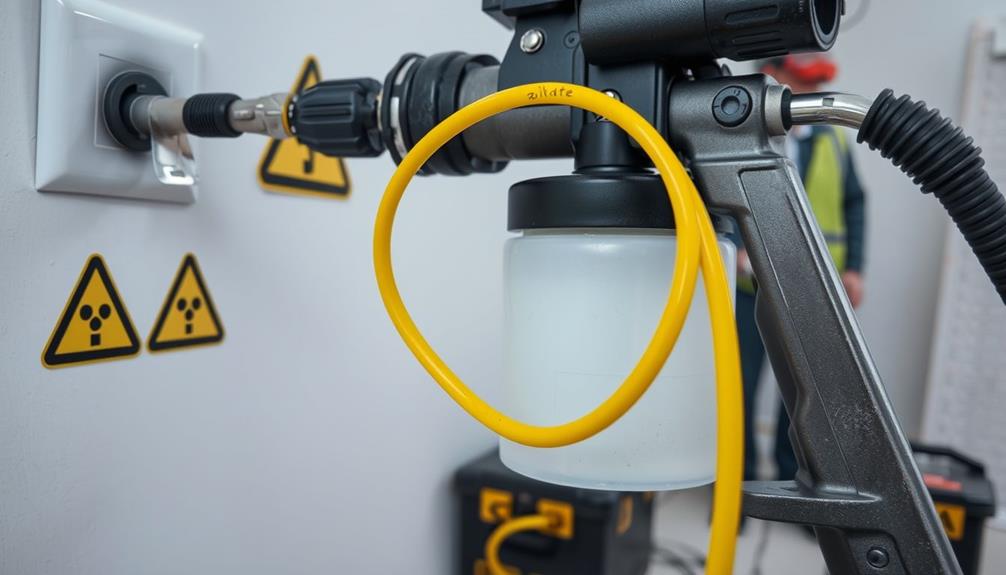
Grounding your airless paint sprayer is essential to prevent static electricity from building up, which can lead to dangerous sparks in flammable environments.
By following proper grounding techniques, you greatly reduce the risk of electrical hazards and guarantee a safer work area.
Regularly check your grounding connections to keep everything secure and compliant with safety standards.
Static Electricity Risks
When using airless paint sprayers, understanding the risks associated with static electricity is essential for guaranteeing safety on the job. Static electricity can build up during spray applications, leading to sparks that might ignite flammable vapors in your workspace.
To safeguard yourself and others, keep these points in mind: Additionally, the implementation of advanced safety protocols can improve your overall protection against potential hazards, similar to how AI security provides robust defenses against cyber threats.
- Ground Your Equipment: Always verify your airless paint sprayer and hoses are properly grounded to prevent static charge buildup.
- Inspect Connections: Regularly check all grounding connections to make sure they're intact and functioning effectively.
- Use Grounded Hoses: Employ grounded hoses and equipment to maintain electrical continuity, helping to dissipate static electricity safely.
- Follow NFPA Guidelines: Adhere to recommendations from the National Fire Protection Association (NFPA) regarding grounding techniques to mitigate risks during spray jobs.
Implementing these practices greatly lowers the chance of fire or explosion, especially when working with flammable materials.
Grounding Techniques Importance
Safety is paramount in spray painting, and understanding the importance of grounding techniques is vital for preventing hazardous situations.
Grounding your airless paint sprayer is essential to preventing static charge buildup, which can create sparks leading to fire or explosion hazards. Additionally, as with cybersecurity measures, maintaining proper grounding is significant in avoiding electrical hazards in environments where flammable materials are present. By connecting your sprayer to a grounded outlet or using a grounding wire, you can safely dissipate static electricity.
Regularly inspect your grounding connections to verify they're intact. Damaged or loose connections can compromise your safety and increase the risk of electrical shock.
The National Fire Protection Association (NFPA) highlights grounding as a significant safety measure, especially in environments with flammable substances.
Regular Equipment Inspections
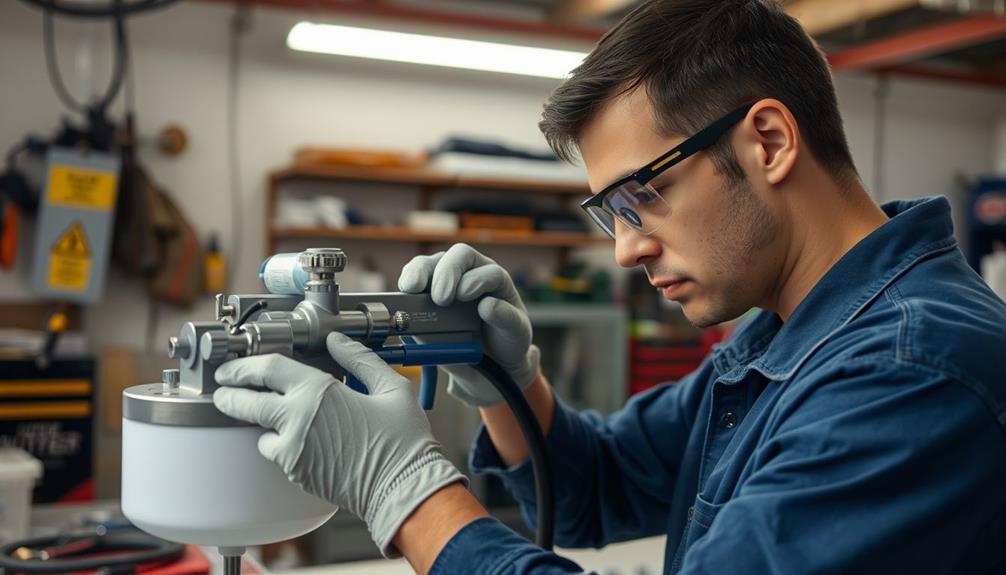
Regular equipment inspections are essential for maintaining the safety and efficiency of your airless paint sprayer. By regularly checking your spray equipment, you can prevent electrical hazards and guarantee smooth operation.
Here are some key inspection points to take into account:
- Hoses and Electrical Connections: Inspect for wear, damage, or leaks. Any signs of deterioration can lead to dangerous situations.
- Grounding Connections: Verify grounding connections are intact to minimize static electricity buildup, which can ignite sparks and cause fires.
- Safety Features: Check that all safety features, like trigger locks and pressure relief valves, are functioning properly. These are critical for enhancing user safety.
- Visual Inspections: Look for frayed wires or exposed electrical components. Address any issues immediately to prevent serious electrical risks.
Additionally, keep an updated operator's manual on hand during your inspections. This reference will guide you on safety protocols and manufacturer recommendations for your spray equipment.
Regular inspections aren't just a good practice; they're essential for your safety and the longevity of your equipment.
Safety Responsibilities and Training
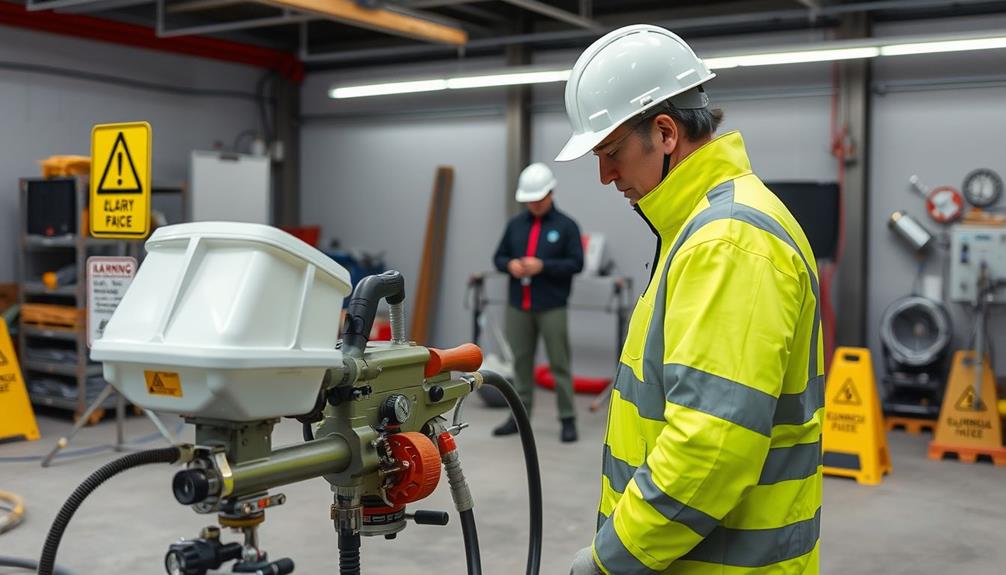
Ensuring safety in airless paint spraying involves everyone, from manufacturers to users. Each party has specific safety responsibilities that contribute to a safer working environment.
Manufacturers like Graco highlight the need for demonstrating safety devices and procedures, ensuring users understand the potential hazards. Distributors must train their staff on safety protocols related to airless spray equipment, preventing accidents and injuries before they occur.
As a user, it's essential that you familiarize yourself with the product's instruction manual. These manuals contain critical safety information and hazard icons that guide you through safe operation.
Regularly reviewing safety protocols is also part of your responsibilities. By staying informed, you enhance your awareness of potential electrical hazards linked to airless paint sprayers.
Engaging in ongoing training and open discussions about safety can solidify these responsibilities across all levels. You'll not only protect yourself but also contribute to a culture of safety within your team.
Frequently Asked Questions
What Are Some Hazards When Using an Airless Spray Gun?
When using an airless spray gun, you face hazards like injection injuries from high-pressure fluid, static electricity risks, flammable vapors in poorly ventilated areas, and potential leaks from damaged hoses. Always prioritize safety protocols.
Is It Safe to Use a Paint Sprayer Indoors?
Did you know that 80% of paint fumes can linger indoors for hours? It's risky to use a paint sprayer indoors without proper ventilation. Always guarantee you're in a well-ventilated area to stay safe.
What Is the Number One Rule When Using Airless Spray Guns?
The number one rule when using airless spray guns is grounding your equipment. This prevents static electricity, which can cause sparks, fires, or explosions. Always prioritize safety by ensuring proper electrical connections and avoiding wet conditions.
What Is a Safety Feature of Airless Spray Guns?
One key safety feature of airless spray guns is the trigger safety lock. This prevents accidental activation when you're not using the gun, helping you maintain control and avoid unintended spraying during your projects.
Conclusion
In the thrilling world of airless paint spraying, you might think dodging electrical hazards is just a game of chance. But let's not treat safety like an exhilarating roller coaster ride! By understanding risks and taking precautions, you can keep your painting adventures both colorful and safe. So, gear up, ground your equipment, and remember: a shocking revelation isn't just a plot twist in a horror movie—it's what happens when safety takes a backseat. Happy spraying!
